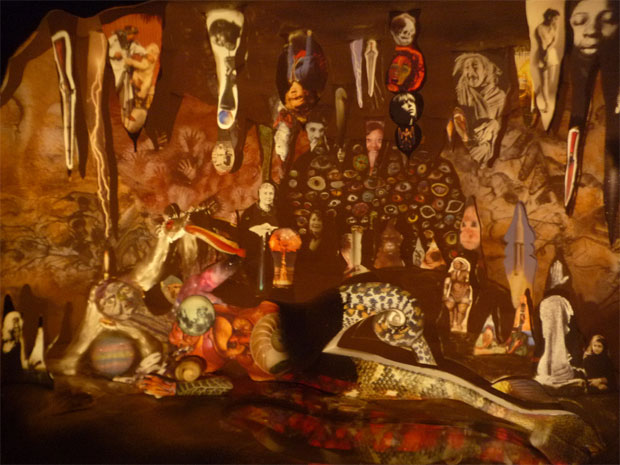First impression of the Canadian pavilion: It’s terrible. A life-size bronze figure sits on the roof of the pavilion while inside, Shary Boyle’s ceramic figurines hold globes circling on old-fashioned Victrolas. As the show’s title, “Music for Silence”, indicates, the room is silent, and the three small figures with globes are overly precious. The large colorful ceramic vignette with a mermaid is garish and just plain tacky.
Second impression of the Canadian pavilion: Actually, it’s not so bad. Spend a bit of time with the ceramic vignette, and three distinct lighting scenarios emerge, each transforming the work. In one case, the mermaid cave, which drips stalactites is covered with an array of projections that include female performers, handprints, a web of eyeballs, a possible Venus of Willendorf, a rocketship, handprints, at least two weapons, two monkey faces, and a lightening bolt. All of this history appears to have been birthed from the gap between an aging woman’s mermaid fin and her single curling snake leg. In another instance, the light changes, and we see only the shadow. It’s almost too obvious a reference to Plato’s Cave—an allegory in which shadows are the only version of reality to the unenlightened cave dwellers—and it’s clear Boyle intends the same from her rotating figurines. Their shadows loom large, as they are cast against a starry black wall.
In a final instance, we see the lighting of the vignette change once again to reveal the raw ceramics of the piece. The cave is a stage, and the figure a Botticelli-like odalisque of sinewy line and voluptuous form. It’s simplicity is pleasing, and adds yet another layer of history to the work.
In this light, the figurines seem less precious; two white figures balance moons on their bellies, while a bronze figure literally uses a net to both mask her face and carry the weight of the world on her back. Such references might add an unnecessary level of pastiche to the work, but frankly, they’re preferable to the relentless abstraction that currently dominates the American contemporary art scene. Unsurprisingly, the first impressions of Sarah Sze’s fastidious, but ultimately empty assemblage installations at the nearby US pavilion, have been mostly positive.



Comments on this entry are closed.